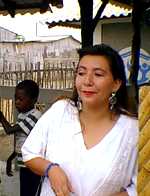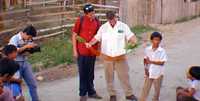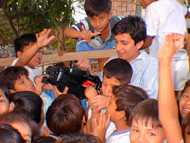|
The surrounding barrios of Guayaquil are foreboding places—disjointed shanty towns strewn with litter and stray dogs. To the unfamiliar traveler, these poor neighborhoods seem dangerous and uninviting. Although Ethan and I arrived in Guayaquil guarded by the warnings of cautious Quitenos, we visited a project that quickly dispelled our prejudices and erased our fears.

 In a development partnership with Esquel, co-directors Rafael Carriel and Marivel Ruiz have created an alternative video education program for the children of five major Guayaquil barrios. For six months now, the Proyecto de Video con Nios de Sectores Populares y Marginales instructs children ages 5-16 in all aspects of video production, including directing, acting, production, set design, and filming. The videos address such issues as drug use, alcoholism, single parenting, and rape. In a development partnership with Esquel, co-directors Rafael Carriel and Marivel Ruiz have created an alternative video education program for the children of five major Guayaquil barrios. For six months now, the Proyecto de Video con Nios de Sectores Populares y Marginales instructs children ages 5-16 in all aspects of video production, including directing, acting, production, set design, and filming. The videos address such issues as drug use, alcoholism, single parenting, and rape.
 The main goal of the Proyecto de Video is teaching children how to critically analyze their surroundings through a creative medium. Many kids do not have normal educational opportunities because parents force them to sing on buses for money or sell candy on the streets. By using a lens to focus on social problems, the children are able to objectively identify unhealthy lifestyles and learn new ways of behavior. For example, children have internalized the aggressiveness of domestic violence in their own actions. By reproducing physical abuse on video, they become aware of the negative effects of violence. While older children handle the more technical aspects of production, the project includes younger children through educational games and exercises. Working alongside the project coordinators, the adolescents serve as positive role models, leading younger children in activities geared towards creative and social development.
The main goal of the Proyecto de Video is teaching children how to critically analyze their surroundings through a creative medium. Many kids do not have normal educational opportunities because parents force them to sing on buses for money or sell candy on the streets. By using a lens to focus on social problems, the children are able to objectively identify unhealthy lifestyles and learn new ways of behavior. For example, children have internalized the aggressiveness of domestic violence in their own actions. By reproducing physical abuse on video, they become aware of the negative effects of violence. While older children handle the more technical aspects of production, the project includes younger children through educational games and exercises. Working alongside the project coordinators, the adolescents serve as positive role models, leading younger children in activities geared towards creative and social development.

 Ethan and I visited a project branch in barrio, Cartagena, that gave us a clearer sense of the project's influence. Riding in the back of Rafael's pickup around twilight, we left affluent North Guayaquil and headed for outskirts of the city. Turning down a side road towards the project, we looked at each other in apprehension. After a long day of visiting projects, we both felt a little weary and suspicious of the foreign neighborhood. All of a sudden, a screaming horde of children came running down the road to greet us. The seventy children of the Talleres CEFOCINE all tried to board the truck, swarming Ethan and I with handshakes and hugs. Ethan and I visited a project branch in barrio, Cartagena, that gave us a clearer sense of the project's influence. Riding in the back of Rafael's pickup around twilight, we left affluent North Guayaquil and headed for outskirts of the city. Turning down a side road towards the project, we looked at each other in apprehension. After a long day of visiting projects, we both felt a little weary and suspicious of the foreign neighborhood. All of a sudden, a screaming horde of children came running down the road to greet us. The seventy children of the Talleres CEFOCINE all tried to board the truck, swarming Ethan and I with handshakes and hugs.
 Our arrival was greeted with banners, a huge greeting card stamped with the hand prints of the children, and prepared speeches by the 11 year old presidents, Johanna and Alfredo. Because the children do not have a center (except on rainy days when they crowd the home of a local mother), they posted signs and art work on the wall of the church they meet outside of every Tuesday and Thursday afternoon.
Our arrival was greeted with banners, a huge greeting card stamped with the hand prints of the children, and prepared speeches by the 11 year old presidents, Johanna and Alfredo. Because the children do not have a center (except on rainy days when they crowd the home of a local mother), they posted signs and art work on the wall of the church they meet outside of every Tuesday and Thursday afternoon. After talking with the kids for some time about their video projects, Johanna and some of the other kids led us through the barrio to Johanna's house. As we walked through the darkened alleys, I have never felt so safe—protected by an army of children. When we arrived, Johanna's mother served us a fruit salad that all the children had purchased and made with scraped money. We sat speechless in the small shack, unable to adequately reciprocate the welcome we had received. After talking with the kids for some time about their video projects, Johanna and some of the other kids led us through the barrio to Johanna's house. As we walked through the darkened alleys, I have never felt so safe—protected by an army of children. When we arrived, Johanna's mother served us a fruit salad that all the children had purchased and made with scraped money. We sat speechless in the small shack, unable to adequately reciprocate the welcome we had received.
 The Proyecto de Video is not only challenging the negative stereotypes of poor Guayaquil barrios, but it is redefining the role of the youth. This child army, led by two remarkable presidents, has totally abandoned lives of violence and aggression. They have attracted groups like Esquel into their neighborhoods through their outward affection and personal motivation. Through video production, the children have taken on the responsibilities of self-determination, and are refusing the intimidation of a previously dangerous neighborhood.
The Proyecto de Video is not only challenging the negative stereotypes of poor Guayaquil barrios, but it is redefining the role of the youth. This child army, led by two remarkable presidents, has totally abandoned lives of violence and aggression. They have attracted groups like Esquel into their neighborhoods through their outward affection and personal motivation. Through video production, the children have taken on the responsibilities of self-determination, and are refusing the intimidation of a previously dangerous neighborhood.
 
|
|




